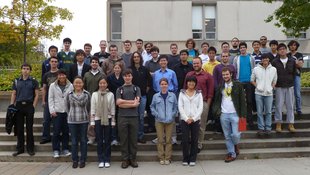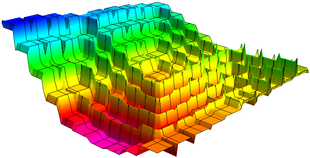10-327/Classnotes for Monday September 27: Difference between revisions
No edit summary |
No edit summary |
||
| Line 16: | Line 16: | ||
[[User:Xwbdsb|Xwbdsb]] 20:26, 27 September 2010 (EDT) |
[[User:Xwbdsb|Xwbdsb]] 20:26, 27 September 2010 (EDT) |
||
*Question1: |
|||
*Question: |
|||
Dror you said in class the set of permutations of 0's and 1's could be mapped "bijectively" onto |
Dror you said in class the set of permutations of 0's and 1's could be mapped "bijectively" onto |
||
the unit interval [0,1] and hence is not countable.Is it true that every real number in the unit |
the unit interval [0,1] and hence is not countable.Is it true that every real number in the unit |
||
interval has more than one binary expansion? Is it possible to map the set of all permutations onto |
interval has more than one binary expansion? Is it possible to map the set of all permutations onto |
||
N union {0}? (the first number stands for 2^0, second stands for 2^1, etc.) |
N union {0}? (the first number stands for 2^0, second stands for 2^1, etc.) |
||
-Kai |
|||
[[User:Xwbdsb|Xwbdsb]] 20:37, 27 September 2010 (EDT) |
|||
*Question2: |
|||
Suppose we have a collection of sets which is closed under intersection. Does it mean that it is closed under |
|||
arbitrary intersecions(i.e. uncountable intersections?) Also, suppose this set satisfies the condition: for any |
|||
A,B in the set, A intersect B is in the set. What can mathematical induction give us? A.the set is closed under |
|||
finite intersections B.the set is closed under countable intersections C.the set is closed under arbitrary intersections. |
|||
And Why? |
|||
-Kai |
-Kai |
||
Revision as of 20:37, 27 September 2010
| ||||||||||||||||||||||||||||||||||||||||||||||||||||||||||||
See some blackboard shots at BBS/10_327-100927-142655.jpg.
Video: ![]() Topology-100927
Topology-100927
| Dror's notes above / Student's notes below |
Here are some lecture notes..
Xwbdsb 20:26, 27 September 2010 (EDT)
- Question1:
Dror you said in class the set of permutations of 0's and 1's could be mapped "bijectively" onto the unit interval [0,1] and hence is not countable.Is it true that every real number in the unit interval has more than one binary expansion? Is it possible to map the set of all permutations onto N union {0}? (the first number stands for 2^0, second stands for 2^1, etc.) -Kai
Xwbdsb 20:37, 27 September 2010 (EDT)
- Question2:
Suppose we have a collection of sets which is closed under intersection. Does it mean that it is closed under arbitrary intersecions(i.e. uncountable intersections?) Also, suppose this set satisfies the condition: for any A,B in the set, A intersect B is in the set. What can mathematical induction give us? A.the set is closed under finite intersections B.the set is closed under countable intersections C.the set is closed under arbitrary intersections. And Why? -Kai

![{\displaystyle [0,1]}](https://wikimedia.org/api/rest_v1/media/math/render/svg/738f7d23bb2d9642bab520020873cccbef49768d)



